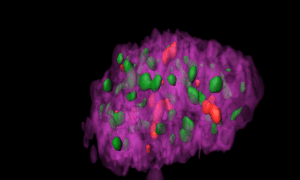IrsiCaixa develops antibodies that block one of the internalization pathways of the Ebola virus into human cells

The study demonstrates that the receptor Siglec-1 is used by different virus, such as Ebola, Marburg and HIV, to enter the myeloid cells and develops novel antibodies against this protein
Ebola is a serious haemorrhagic disease that has no treatment and it is lethal in approximately the 50% of the cases. Currently there are vaccines and antibodies against Zaire, one of the species of the Ebola virus, in the experimental phase. However, those strategies do not cover other viral variants which can potentially cause future outbreaks. Now, researchers from IrsiCaixa have discovered that filovirus, family that includes Ebola, enter into the myeloid cells through the same pathway as HIV, which was previously described. The study is published in the Nature Microbiology journal.
In the case of viruses with high genetic variability, such as HIV, strategies must block different viral targets in order to be efficient. Since it is really complex to know which of the Ebola species will cause the future outbreaks, the researchers decided to study the viral receptor of the target cell which is shared between different species and offers the possibility to block the entrance of different type of viruses at the same time. “We discovered a new receptor and developed different antibodies to block it” says Nuria Izquierdo-Useros, associate researcher at IrsiCaixa and co-leader of the article.
The study demonstrates that the Filoviridae viruses, including Ebola and Marburg virus, use the same mechanism to enter the myeloid cells, which are the cells in charge of activating the immune response against infections. All of them use the protein Siglec-1, a surface protein of the myeloid cells that enables the viral entry to these cells.
In order to demonstrate that Siglec-1 is a host entry factor, they used Ebola Virus-Like Particles (VLPs) which can recapitulate the viral entry and can be handled safely in the laboratory. Using antibodies against Siglec-1, they proved the capacity to block the Ebola entrance into the myeloid cells, such as dendritic cells, monocytes and immune cells from the lymphoid tissues, which are the main targets before expanding to other organs and tissues.
Daniel Perez-Zsolt, researcher at IrsiCaixa and first author of the article, says “the antibodies that we developed could be useful for any viral specie, and that is really positive. We used Ebola and Marburgo VLPs and in both occasions we observe a blocking effect”.
The next steps will be testing the antibodies with real viruses in animal models, but this will require higher biosecurity levels. If they confirm the results with these experiments, the antibodies could be used to prevent or treat the infection, combining them with other drugs since Siglec-1 is not the unique pathway that virus use to entry the cells. “An antiviral strategy against Ebola must be efficient in all the entry pathways of the virus into the cell and we have not identified all of them yet. We must close all the internalization pathways, and we already blocked one of them”, explains Javier Martínez-Picado, ICREA researcher at IrsiCaixa and principal investigator of the group. During the project, the authors also collaborated with the Leonor Kremer’s group at the National Centre of Biotechnology (Madrid).